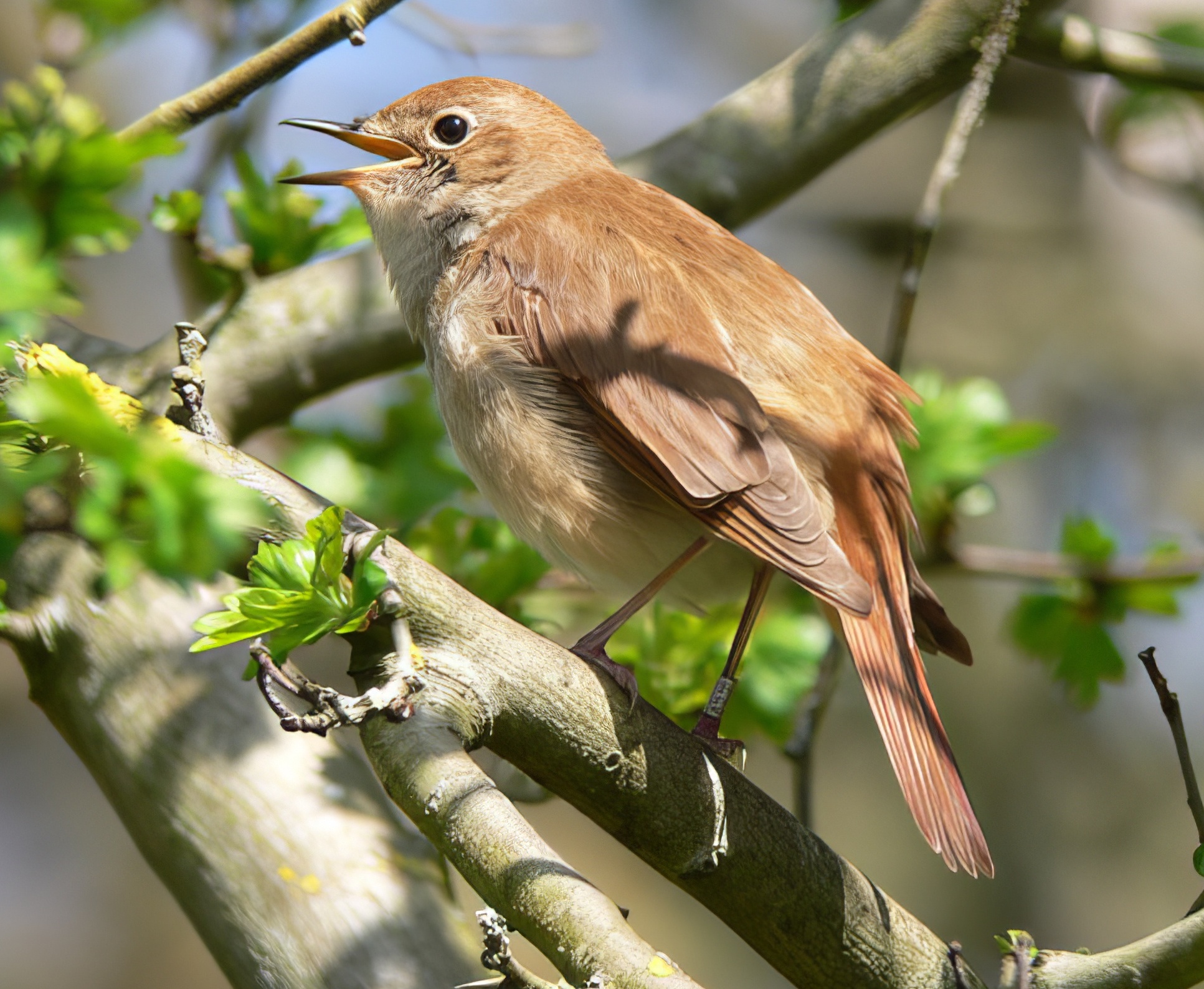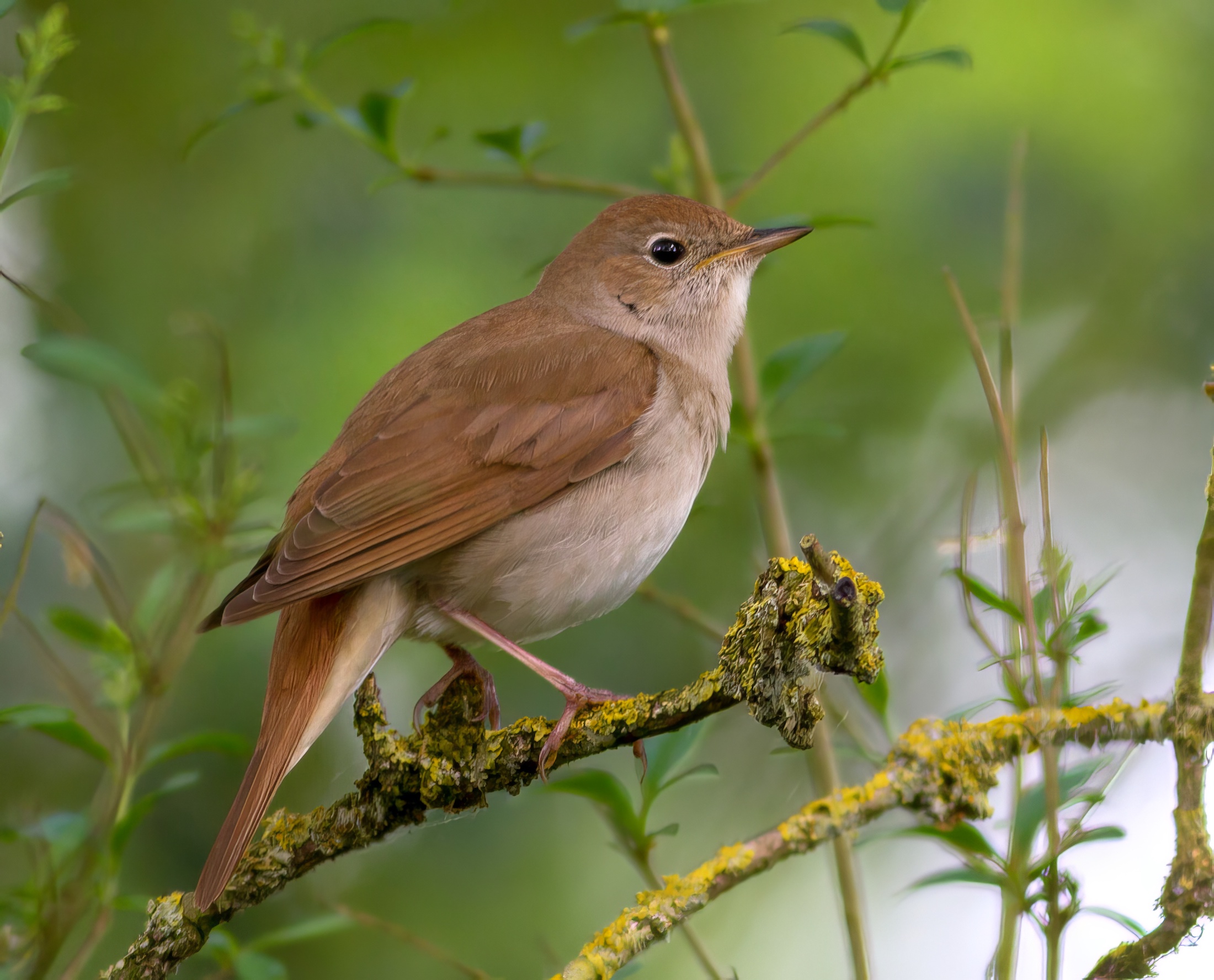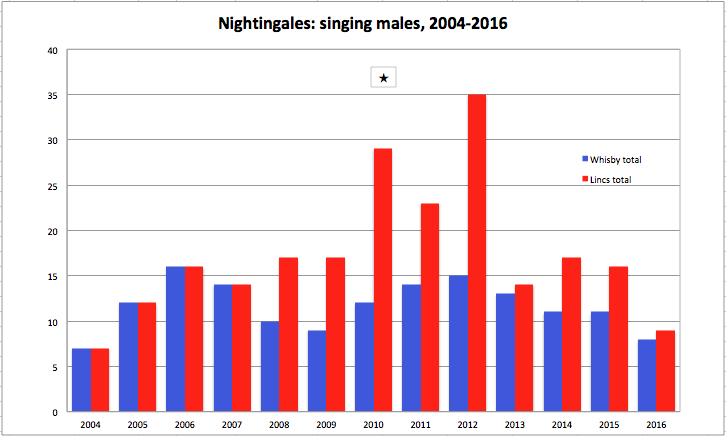Common NIghtingale Luscinia megarhynchos
Very Scarce and declining local summer visitor and very scarce passage migrant; usually arrive from the second week of April onwards and most leave before the end of July.


National Nightingales surveys
A national survey of more than 3000 sites in 1999 indicated a contraction in range towards the core in southeast England, although there was little evidence of a change in the size of the British Nightingale population (Wilson et al 2002). This decline has continued throughout Britain, and the BTO BBS reported an estimated decrease in breeding numbers of 60% between 1995 and 2009 (Risely et al2010). The national survey was repeated in 2012 and derived 12 estimates for the UK that varied between 5,094 and 5,938. The authors felt that this may have been a slight over-estimate. By contrast, they considered the previous population estimate of 6,700 in 1999 was almost certainly an under-estimate (Hewson et al2018)
Lincolnshire Nightingales
The results from Lincolnshire in the 1999 survey found that the number of singing males had fallen from 159 in the 1980 survey to 90. By the time of the 2012 survey, just 35 singing males were detected from around 28 sites and 15 of this total were at Whisby Nature Reserve. The number of sites checked in 2012 was significantly more than usual and in part, at least, accounts for the peak count during the period 2004-2016.

The chart shows the total numbers of singing males in Lincolnshire and in the Whisby Recording Area that included North Hykeham from 2004 (see Nightingales at Whisby Nature Reserve, below. (« Note that 2012 was the year in which a national Nightingale census took place and coverage was more comprehensive than usual).
Nightingales at Whisby Nature Reserve
A summary of Nightingale recording at Whisby Nature Reserve has previously appeared in the Lincolnshire Bird Report (Hopwood 2012). He noted that the first bird to be documented there was in 1985, probably having been derived from the Lincolnshire lime woods to the east, which at the time was a traditional stronghold. The Whisby Recording Area has included North Hykeham Pits from 2004 onwards as the area represents a habitat continuum for Nightingales. Prior to 2004, the numbers are likely to have been under-recorded and the chart above reflects the more comprehensive coverage from 2004 onwards.
The arrival dates of singing males between 2008-2016 have varied over the dates April 8th-15th and numbers of males at Whisby peaked in 2006, when there were 16. The total since then has reached double figures in eight of the following nine years to 2015. The only other singing male in potentially suitable breeding habitat in 2016 was one heard in Bourne Wood on May 16th. Most Nightingales in the county have departed their breeding grounds by the end of July, with the latest records being of birds seen on 11th August (in both 2009 and 2015).
Factors known to affect Nightingale abundance in Britain include conditions of the wintering grounds and habitat change on their breeding grounds. The species winters in West Africa south of the Sahel and subsequent intensification and expansion of agriculture, cutting for firewood and building materials may have reduced habitat availability for Nightingales and other wintering passerines (Ockendon et al 2012). In Britain, reduction of suitable breeding habitat by browsing deer, especially Roe Deer but also Reeve’s Muntjac, was shown to be especially significant for Nightingales as well as for Willow Tits (Newson et al 2012). In the face of such significant pressures on their breeding and wintering grounds, it remains to be seen whether this species can hang on as a breeding species in Lincolnshire.
Migrant Nightingales away from breeding areas
Most migrants are recorded at the well-known coastal sites in the county where it is rare and not quite annual. Between 1997-2007, county reports were incomplete, so recent migrant dates are taken from 2008 onwards when full reports were again available. The earliest record of a spring migrant was of one on April 3rd 2010 at Gibraltar Point. Other April records during 2008-2016 were at Huttoft Bank (April 12th 2016), Gibraltar Point (April 14th and 23rd 2011) and at Donna Nook (April 20th 2011). Most coastal records come during May with just 1-3 birds seen on the coast, largely at Donna Nook, Huttoft, Saltfleetby-Theddlethorpe NNR, and Gibraltar Point. Most are present on only one or two dates, but Gibraltar Point has recorded two long stayers during this period: in 2010 (April 29th – May 28th) and 2012 (May 19th–June 1st). Unusually, a female with a brood patch was trapped at Gibraltar Point on June 7th 2015. It is not known if this was breeding locally, or was perhaps a recently failed breeder from elsewhere. Autumn records at coastal sites are exceedingly rare with one at Gibraltar Point on August 1st 2011 the only coastal record during 2008-2016.
References
Hewson CM, Miller M, Johnston A, et al (2018). Estimating national population sizes: Methodological challenges and applications illustrated in the Common Nightingale, a declining songbird in the UK. J. Appl.Ecol.00:1–11.
Hopwood, G. (2012). Nightingales Luscinia megarhynchosat Whisby Nature Reserve. Lincolnshire Bird Report 2012, 173-175.
Newson, S.E., Johnston, A., Renwick, A.R., Baillie, S.R. and Fuller, R.J. (2012). Modelling large-scale relationships between changes in woodland deer and bird populations. J. Appl. Ecol.49: 278-286.
Ockendon, N., Hewson, C.M., Johnston, A. & Atkinson, P.W. (2012). Declines in British-breeding populations of Afro-Palaearctic migrant birds are linked to bioclimatic wintering zone in Africa, possibly via constraints on arrival time advancement. Bird Study, 59:2, 111-125.
Risely, K., Renwick, A. R., Dadam, D., Eaton, M. A., Johnston, A., Baillie, S. R., Musgrove, A. J. and Noble, D. G (2011). The Breeding Bird Survey 2010. BTO Research Report 597, Thetford: British Trust for Ornithology.
Wilson, A. M., Henderson, A. C.B. and Fuller, R. J. (2002). Status of the Nightingale Luscinia megarhynchos in Britain at the end of the 20th Century with particular reference to climate change. Bird Study 49: 193–204.
(Account prepared June 2018; updated with reference to the new Birds of Lincolnshire (2021) December 2022)
